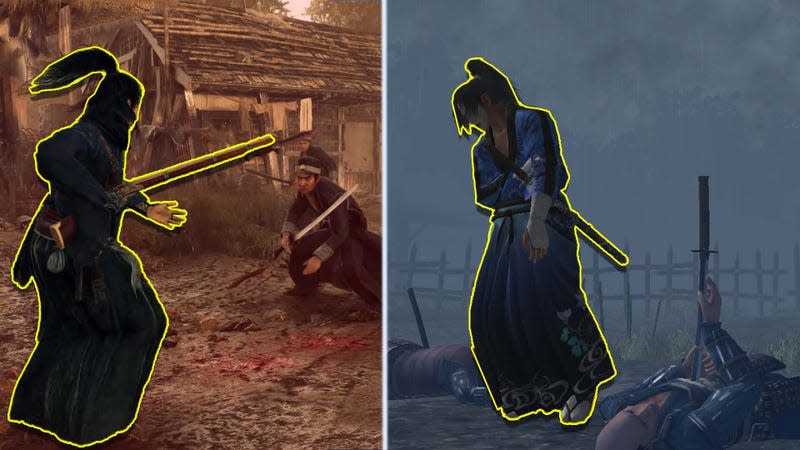Rise Of The Ronin Is This Obscure Samurai Game’s Spiritual Successor

I’ve been having a great time with Rise of the Ronin, Team Ninja’s open-world samurai action game that launches as a PlayStation 5 exclusive on March 22. Not only are there a plethora of cats to find and pet, but there’s also a wealth of freedom in how you live your life during Japan’s Bakumatsu period (or the final years of the Shogunate). There are echoes of Sucker Punch Productions’ studio’s Ghost of Tsushima, sure, but the latest game from the Nioh and Wo Long: Fallen Dynasty team has a lot more in common with a lowkey samurai game from the aughts you might not have heard of. You could say that this obscure game had to walk so Rise of the Ronin could run.
Read More: 14 Tight Samurai Games You Should Play Right Now
Set in 19th century Japan, Rise of the Ronin tells the story of a civil uprising amid bacterial infection and political turmoil as foreign settlers show up to pry the country open to overseas trade. You play a nameless and masterless ronin who must form bonds with various historical figures to help steer the direction of Japan’s future. The point, then, is to steer the direction of Japan’s identity. It’s an intriguing story, one filled with passion and rage as the conflicting factions clash in a bloody dance of bullets and swords toward liberation. I love it, and it makes sense why. Rise of the Ronin reminds me of Way of the Samurai, a series of open-world games that started in 2002 by the Octopath Traveler studio Acquire.
Way of the Samurai laid Rise of the Ronin’s foundation
Way of the Samurai was released in 2002 for the PS2 and PSP. Developed by Acquire, it’s also set during Japan’s 19th century, and you also play as a ronin a decade after the Bakumatsu. Caught in a power struggle between the villagers and an assortment of clans vying for power now that the Tokugawa Shogunate has been eradicated, you form bonds with a variety of characters that influence the story. The decision-making and story setting aspects alone are enough to underscore the similarities between Rise of the Ronin and Way of the Samurai, but it doesn’t stop there. (The two are even more alike when you get to 2010's Way of the Samurai 4 on PS3, a game set during the Bakumatsu with American and European forces attempting to strong-arm the nation into opening its borders.) From the variety in character customization to the figures you meet along the way, to the occasional campiness, Rise of the Ronin truly feels like a spiritual successor to Way of the Samurai.
This is especially true when you compare both game’s combat. In the Way of the Samurai titles, you can create your own katana and customize the moves you use from an assortment of unlockable combat styles. There’s something for everyone: a style that focuses on quick strikes and nimble movement, a style that’s all about power and pressure, a style that hones in on the quick draw (also known as Iaido, the combat style I always choose). Rise of the Ronin has a similar system. You can’t build a wholly new katana like you can in Way of the Samurai, but, much like Nioh’s stance switching, you can swap between an abundance of combat styles, many of which mirror the ones in Way of the Samurai (such as Iaido).
Read More: I’m Here For Everything Rise Of The Ronin Is Serving
Combat is satisfyingly crunchy in both Rise of the Ronin and Way of the Samurai, with flashy swordplay and gruesome dismemberment acting as the pillars of their mechanics. And their depth of customization allows you to forge a ronin that aligns with your playstyle, providing a unique way to interject yourself into the story. It rules, and if you like Rise of the Ronin or just open-world samurai action games in general, then you should give Way of the Samurai a shot. This series is 20 years old now, but you can feel the DNA it shares with Rise of the Ronin. You can buy Way of the Samurai 3 and 4 on Steam for hella cheap, or you can snatch up Way of the Samurai 3 for $20 if you still have your Xbox 360. It’s worth it.
There’s a lot more I want to say about Rise of the Ronin, but you’ll have to wait until the full Kotaku review drops when the game launches on March 22. The combat, the story, the world, the drama of it all has kept me utterly hooked, despite the open-world busywork. It’s not quite Dark Souls, so don’t call it a Soulslike. And it’s not quite Ghost of Tsushima, so don’t call it a clone. Instead, think of Rise of the Ronin as a greatest hits album by Team Ninja.


